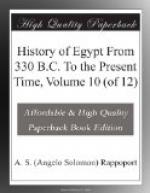But a much greater difficulty consisted in the fact that the chronological reports of the earlier history were all arranged according to the reigning years of the rulers, so that Manetho was obliged to construct an era for his work. Boeckh was the first to discover with certainty the existence and form of this era. According to his researches, the whole work of Manetho is based upon Sothicycles of 1460 Julianic years. The Egyptian year was movable, and did not need the extra day every few years, but the consequence was that every year remained a quarter of a day behind the real year.
[Illustration: 131.jpg MODERN SPHINX-LIKE FACE]
When 1460-1 years had elapsed this chronological error had mounted to a whole year, and so the movable year and the fixed year fell together again. It is this Sothic period which Manetho has employed in his account of Egyptian history. Besides his history, Manetho has left us a work on astrology, called Apotelesmatica, or Events, a work of which there seems no reason to doubt the genuineness.
It is a poem in hexameter verse, in good Greek, addressed to King Ptolemy, in which he calls, not only upon Apollo and the Muse, but, like a true Egyptian, upon Hermes, from whose darkly worded writings he had gained his knowledge. He says that the king’s greatness might have been foretold from the places of Mars and the Sun at the time of his birth, and that his marriage with his sister Arsinoe arose from the places of Venus and Saturn at the same time. But while we smile at this being said as the result of astronomical calculations, we must remember that for centuries afterwards, almost in our own time, the science of judicial astrology was made a branch of astronomy, and that the fault lay rather in the age than in the man; and we have the pain of thinking that, while many of the valuable writings by Manetho are lost, the copiers and readers of manuscripts have carefully saved for us this nearly worthless poem on astrology.
Petosiris was another writer on astrology and astronomy who was highly praised by his friend Manetho; and his calculations on the distances of the sun and planets are quoted by Pliny. His works are lost; but his name calls for our notice, as he must have been a native Egyptian, and a priest. Like Manetho, he also wrote on the calculation of nativities; and the later Greek astrologers, when what they had foretold did not come to pass, were wont to lay the blame on Petosiris. The priests were believed to possess these and other supernatural powers; and to help their claims to be believed many of them practised ventriloquism.




